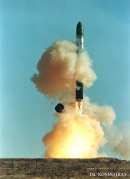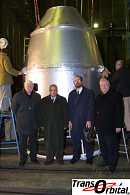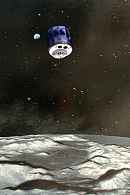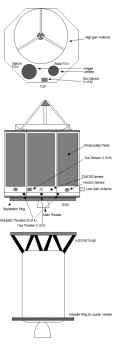|
An
Interview* with Paul Blase
Co-founder of TransOrbital -
The company TrailBlazing commercial exploration of the Moon
*
via email
|
This autumn
the small startup company TransOrbital
intends to send its TrailBlazer
spacecraft into orbit around the Moon. The mission
would become the first commercial space exploration project and
only the second#
privately financed spacecraft to go beyond geostationary orbit.
The company
seeks to pay for the project in several
ways. The spacecraft will transmit high definition video of
the lunar surface, including views of the American (Apollo) and
Russian (Lunakhod) landing sites, the poles and the far side.
The company will create a high-resolution lunar
surface atlas and sell the imagery for scientific and commercial
applications. A time
capsule carrying personal messages, photos, and mementos from
paying customers (see their on
line catalog) will come to rest on the Moon when the mission
ends and the vehicle crashes into the surface.
Last December
TransOrbital launched a structural mockup of the spacecraft on
a Dnepr
rocket built by the Russian/Ukranian Kosmotras
company. In August the company announced
that it had received all necessary licenses from the US government
for its lunar mission.
|
 The
TrailBlazer structural mockup launches aboard a Russan Dnepr
rocket
on Dec.20,
2002
The
TrailBlazer structural mockup launches aboard a Russan Dnepr
rocket
on Dec.20,
2002 |
|
Paul
Blase, Chief Technical Officer and co-founder of TransOrbital, here
discusses with me the status of the project, the challenges of getting
such a mission underway, how activists can contribute to space hardware
development, and what TrailBlazer will mean for commercial exploration
and development of space.
[Note:
TransOrbital has been a very appreciated advertiser at HobbySpace
for over a year; not that this affected my usual
hard-edged grilling in any way. ; -> ]

Paul
Blase, 2nd from right, stands in from of the payload capsule
for the December launch.
(Large
image) |
|
HS:
Can
you give a general status report on the Trailblazer project? What
is the target date for launch?
Blase:
Target date for launch is at the end of the year, nominally October.
The exact date depends on our ability to secure the sponsors and
(large scale) customers that we need to reserve the launch vehicle.
This is going well, but the current state of the economy and the
looming conflict with Iraq means that it's going slower than we
had hoped
HS:
How
soon before the launch do you have to take it to Russian for installation
on the rocket?
Blase:
30 days. About
a week before launch they close the payload capsule for transport
to the launch silo. At about the same time, one month prior to
launch, launch customers have to have a mass simulator test article
at the Yuzhnoye Design Bureau, Ukraine, for the fit test/vibration
test/sep test - see www.transorbital.net/gallery.html
We don't have to do this, since the structural test article that
we launched in December fulfilled this requirement.
|
HS:
What
did you learn from the successful December launch of the structural
test satellite?
Blase: Primarily how to work with Kosmotras. We learned a great
deal about the facilities, the testing requirements, how the whole integration
procedure works, what to do and what to avoid, and how things will operate
for the full-up launch. I also got a good survey of what we will and
won't be able to provide regarding launch footage for the actual launch
(primarily what the Baikonur Cosmodrome - which is a closed military
reservation - will and won't let us do).
|
HS:
Could you give some us a description of how TransOrbital went
about designing and building the Trailblazer? For example, we
hear a lot about how small firms can take better advantage of
cheap-of-the-shelf hardware. Were you able to rely on a COTS approach
for most of your hardware? What are some of the items that you
found it necessary to make yourselves?
Blase:
TransOrbital has a core group of systems engineers and people
knowledgeable in the construction and flight of small spacecraft.
For instance, Randy Owen of Space
Imaging and Rich Van Allen of Microcosm
are among our advisors. From that, we work with a group of consultants
and small spacecraft companies that provide the specialized expertise
and components.
For
instance, we have one company that is designing the spacecraft
structure, another that is building the radio transmitters and
receivers, and consultants that do the thermal, stress, and vibration
analyses. Some of the parts are made specifically for spacecraft,
namely the propulsion system and the radio units. Others are "hardened"
commercial units that have been ruggedized for the space environment,
namely the cameras and imaging computers.
|
 TrailBlazer over the
TrailBlazer over the
lunar surface |
|
The main items that
we're making ourselves are the spacecraft frame and various mechanical
components.
HS:
Can
you say roughly how far along you are in the spacecraft assembly?
Blase: Still
working on the separate component assemblies.
HS:
Will
you build and run a ground station yourselves or subcontract this out?
Blase: The
transmitter/receiver stations are being subcontracted out. There are
several companies out there that have excellent ground station facilities
for rent, and there's no reason for not using them. We will put together
Mission Control ourselves - but it will be based on commercially available
workstations and software.
|
|
HS:Judging
from the tremendous publicity that TransOrbital received when
it announced the licensing arrangements and then later with the
prototype launch, there will be a lot of attention as the launch
approaches and during the mission. Has this level of attention
surprised you? Has it inspired any new ideas on how to make the
most of the mission? Has it helped to attract any major sponsors
seeking to post logos on the spacecraft?
Blase:
To some degree yes, it did catch us by surprise - but then we
were hoping for it. It has definitely given us a good feel for
the amount of public support for this kind of space mission. It
is helping to attract logos, but there are other factors at work
there too. It certainly helps our case considerably.
HS:
Each day the vehicle will image the surface for an hour during
its closest approach to the surface and then spend most of the
rest of the day downloading the data to earth. I was wondering
if there will be a membership arrangement where one can log in
every so often and watch the latest video as it arrives?
|
Blase: We'll
work out some kind of "webcam" arrangement. Most of the video, of course,
will be reserved for sale, both as commercial video and to the retail
market (e.g. we're going to put out a DVD collection of the lunar imagery).
However, we're going to find some way to put some of the video online
for people who are following the mission. We're trying to find a good
way to have people actually be able to talk to a web server on the spacecraft
(using the Interplanetary
Internet protocols being developed by NASA and various private
groups) and get the latest snap shot.
HS:
Sounds great. I would encourage you to develop
interactive services that provide some degree of a "you are there" sensation.
If one could watch the video in "near" real-time and get a feeling of
actually being there on the spacecraft watching the Moon go by, it would
be terrific.
Blase: We'll
see what we can do. However, we're constrained by the fact that we have
to reorient the spacecraft to download the video stream. We can only
return real-time video from the main cameras when we're pointed at Earth.
With the telemetry stream, we can return snapshots at a reduced data
rate. (In order to maximize reliability, we're avoiding mechanical mechanisms
as much as possible, like camera or antenna gimble platforms).
HS:
It
sounds as if a major part of the challenge of the project was dealing
with all of the red tape involved with launching on a Russian rocket.
This must have been especially burdensome for a small startup company
without a team of lawyers. Many micro-satellite
groups, especially at universities, have had tremendous problems
finding low cost rides to orbit. Do you think that your "trailblazing"
with the Dnepr will make it easier for other groups to use that vehicle
after you've set this precedent?
Blase:
Absolutely. Although I will note that the first 3 launches of the
Dnepr have carried university micro-sats, primarily European spacecraft.
We will certainly make the launch vehicle more accessible for American
users. I might note that there is excess capability available on the
spacecraft that we have reserved, including the TrailBlazer launch,
and anyone interested can contact us. We can also offer assistance in
applying for the proper export permits, logistics, and launch preparation.
HS:
I'll try to get the word
out about the spare seat.
Blase: Thanks.
HS:
To profit from all that work,
have you guys considered a side business in which you would arrange
such launches for other groups?
Blase:
Yep, although that's taking second priority. Anyone interested in working
with the Dnepr launch vehicle can contact us.
|
HS:
As
I understand it, TransOrbital and Trailblazer are spin-offs of
the Artemis Project, which began several years ago as a study
group looking at ways to commercialize development of the Moon.
Can you say something about this connection to Artemis and how
TransOrbital was initially inspired?
Blase:
To synopsize things greatly, and hopefully not offend anyone,
The Artemis Project is an on-line
chat group for people interested in commercial, private lunar
colonization. TransOrbital started out as a working group that
was exploring the lowest-cost, commercially feasible lunar spacecraft.
Landers and rovers were just a bit too much, but a limited duration
imaging mission turned out to be just possible.
|
|
HS:
Another
innovative Moon mission, the Lunar
Prospector also started out as an activist project [in the late
1980s] led by the Space Studies
Institute and the Houston
Space Society. They made considerable progress in developing the
design and some of the instrument hardware but they couldn't raise the
money needed to make it happen. Instead the project eventually evolved
into a NASA Discovery mission with Lockheed-Martin building and operating
the spacecraft.
Blase:
Yep, and we're building on what they started. They were trying more
for an "amsat" type mission, where people put in their expertise, but
it wasn't expected to be able to pay for itself commercially. Trailblazer,
on the other hand, is specifically aimed at supporting itself through
cargo carriage and image return.
|
HS:
Do
you think it is fair to say that space activist groups are great
at coming up with new ideas but to take a promising concept into
the real world they need to spin it off into a company that can
focus on it and raise the resources needed to make it happen?
Blase:
Definitely. For some reason that I do not fully understand, the
amateur radio community can make it work - probably because amateur
radio is a hobby of technically capable people, but it's not what
they do every day. On the other hand, you get very few aerospace
people capable of constructing spacecraft whose hobby is space
advocacy and who are willing to put in hours after work to build
one. Also, while amateur radio operators are historically willing
to support the construction of a satellite so that they themselves
can "work" it, space advocates don't seem to want to support efforts
that they themselves aren't involved in. We have actually received
very little support to date from any space advocacy organization.
|
HS:
I'm
glad you mention hams and their very successful space projects. One
of the reasons I started HobbySpace was
that I saw this huge gap between the space activist community that talks
about space and the AMSAT/Space
Radio community that has actually been DOING real space stuff
of great significance for decades. (It's only a slight exaggeration
to say that AMSAT invented microsats.) I wanted to get the word out
to space enthusiasts that they can use the AMSAT community as a role
model for how to develop low cost space projects.
Blase: Ulterior
motive: I'm KA9CMI.
HS:
I
think there should be a NSS
[National Space Society] supported AMSAT or student satellite. Every
chapter should have its own little PC based ground station, if only
for scanning satellite transmissions. (I should note that the Australian
Mars Society, at least, is planning an AMSAT [JAESAT]
to provide messaging among the society's habitat projects. And there
is some involvement of the German
[chapter of the] Mars Society with AMSAT-DL's
Mars probe
based on the Phase-3D/AO-40
spacecraft.)
In
TransOrbital's case I would guess that a lot of space enthusiasts still
are only vaguely aware of your project and most don't know that they
can put messages & mementos on your time capsule disk that will end
up on the lunar surface. The activist organizations should certainly
get behind it and other such [commercial] projects and encourage their
members to support them.
HS:
What advice in general would you give the
many groups out there trying to develop space related ideas?
Blase: The
business plan is all important. How are you going to pay for it - or
better yet make it pay for itself. Also, venture capitalists don't invest
in neat ideas, they only invest in going revenue streams. You have to
find "angel" investors that like to dream big, and have deep pockets
to support those dreams.
|
|
HS:
Trailblazer
will be the first non-governmental space mission outside of earth
orbit. The fact that TransOrbital will be achieving many such
"firsts" must be tremendously exciting but also rather sobering.
Blase:
Definitely.
Learning "the system" has been very .... educational.
HS:
As
TransOrbital went about attacking the many technical and regulatory
challenges, have you felt that you had to take special added consideration
and responsibility for the fact that the precedents you set will
have big ramifications for future private, commercial space ventures?
Blase:
Definitely. For the most part the licenses that we've had to obtain,
the Remote Sensing Permit from NOAA and the export permit from
State, are routine. However, we did receive a considerable amount
of close attention because of our being the first of our kind.
We foresee even more of this, particularly if we are successful
in creating our planned follow-on lander missions.
The whole
issue of property rights in space in general and on the Moon in
particular is up in the air. (The issue of claiming land aside,
since we're not planning on it at present - how do we legally
keep other explorers from mucking with our multi-million dollar
landers?).
|
HS:
Other groups have talked about commercializing space exploration such
as Spacedev's plans
for asteroid prospecting. However, their approach to raising money for
such missions has been to try to sell data rights to NASA beforehand,
or to sell space on their spacecraft for NASA instruments. When you
were first designing the mission, did you contact NASA to see if you
could make such an arrangement?
Blase: We're
been talking to NASA, but in general we're not counting on them for
a revenue stream. Primarily because of SpaceDev's limited success. There's
much more potential in the commercial market place. Again, Trailblazer
is specifically designed for the commercial market place, not the government
(although we can carry experiments if asked).
HS:
Besides Spacedev I should have also mentioned that Team
Encounter has gotten some NOAA money for its solar sail development
and I also believe it will carry a NASA star compass prototype from
the New Millennium program. So maybe these agencies are starting to
take private ventures more seriously.
Blase: I
hope so. NASA's primary purpose _should_ be to develop technology for
and support private industry, like the NACA did before it and the "aeronautics"
half does now.
|
HS:
Can you say something about TransOrbital's follow-on projects
to Trailblazer?
Blase:
We're
planning a number of landers and additional orbiters. In general,
we want to provide the infrastructure to enable others to explore
and utilize the Moon, including high-resolution images of landing
sites, communications relays, and data handling services.
|
 TransOrbital's
Electra I lunar lander concept.
TransOrbital's
Electra I lunar lander concept. |
|
HS:
Thanks Paul! Best of luck to TransOrbital and bon voyage to TrailBlazer
You
can also find two audio interviews (Dec.25.02
& Jan.29.02)
of Mr. Blase by David Livingston
in the archives at The
SpaceShow.
Paul
Blase can be contacted via pblase@transorbital.net.
#
Hughes' AsiaSat
3 communications satellite, placed into the wrong orbit by a malfunctioning
booster, used the Moon to swing itself into geostationary orbit. First
Commercial Lunar Mission Reaches the Moon - Space Frontier Foundation
- May 13, 1998.
|





